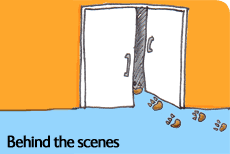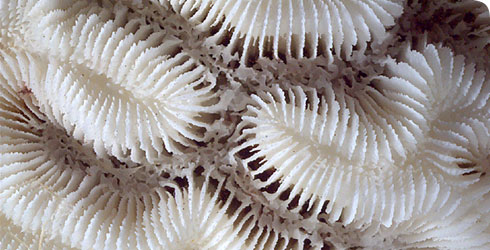Costosepta morphology
What are costosepta?
In Diploria labyrinthiformis, numerous plates (septa) are aligned more or less at right angles to the valley walls, with 12-24 per cm of valley length. These give a double comb-like appearance to the valleys.
The septa form crests (costae) across the walls. A single septum is continuous and integral with its respective costa. The complete structure is a costoseptum.
Appearance and pattern of costosepta
Costae slope down and across the coenosteal ridges that separate the valleys. Costae on the paired walls of the coenosteal ridges do not quite meet each other.
Septa also slope steeply down into the central axis (fossa) of the valleys, but close to the fossa they are usually inflected into a less steep lobe-like segment (paliform lobe) before descending again to the fossa.
Septa occur in 2-3 size orders, with respect to:
- how far they extend towards the fossa
- how high their costae are
Smaller sizes alternate more or less regularly with larger sizes. In the valleys smaller septa sometimes curve towards and join the larger ones. The longest septa reach as far as the valley axes.
Opposing septa within a valley do not meet directly but merge into a more or less continuous structure (often called a columella, or more strictly, an axial structure).
This axial structure occupies up to half the valley width and consists of:
- small irregular plates
- twisted elements running along the valley axis
Micro-morphology of costosepta
Costosepta are mostly imperforate except towards the fossa.
They bear regular strong blunt teeth along all of their edges. These project more or less upward from the edges except close to the fossa where they project at various angles and contribute to the axial structure.
Costoseptal faces bear small, fine spines or granules aligned in rows perpendicular to costoseptal margins. Rows may merge into fine ridges.
Internal structure of colonies:
- Valley walls are formed by lateral thickening of adjacent costoseptae.
- Valleys are floored by blistery plates (dissepiments) which occur repeatedly in vertical section through the colony.
The internal structure of the coenosteal ridges is similar.
Toolbox

Our scientists study the snails that host the schistosomiasis parasite, which causes a disease that affects nearly 200 million people.
